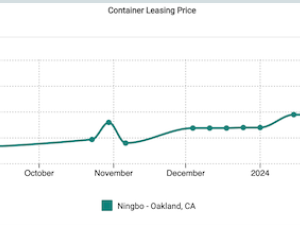Faced with a projected 10-12% trans-Pacific cargo growth in 2005 on top of already record volumes, port and inland rail terminal operators are scrambling to improve landside throughput capacity for international container traffic. Container shipping lines in the Transpacific Stabilization Agreement (TSA) warn that they are already being hit with reductions in free time allowed in terminals before loaded containers are picked up by freight shippers or their representatives, and higher penalties for exceeding those free-time allowances.
At the same time, major railroads have also imposed intermodal container traffic allocation schemes out of port areas, to ensure that container trains do not crowd out bulk coal, agricultural, chemical and other shipments along key US rail corridors. This has placed both an operational and a cost squeeze on ocean carriers to keep cargo moving after it leaves the ship, and to optimize equipment velocity and utilization ' an objective shared by all parties involved in supply chain management.
"The message ocean carriers are getting from port and inland rail terminal operators is very clear ' time is too tight and space too scarce to warehouse containers," explained TSA Executive Director Albert A. Pierce. "Cargo needs to flow quickly to its ultimate destination or to an off-dock distribution facility; importers and consignees need to take delivery right away and release the container equipment, or face sharply higher storage charges."
TSA noted that Burlington Northern Santa Fe (BNSF) will reduce its free-time allowance to the day of notification plus 24-48 hours for its major intermodal yards, with storage charges of $100-150 per day, effective May 1, 2005. Also on May 1, Union Pacific Railroad will raise its existing storage charges by $50 per day and introduce a third tier charge of $300 per day for shipments stored more than 11 days; and CSX will increase its charge for shipments left more than 11 days, to $200 per day.
Marine terminals are beginning to take similar steps. Six Port of New York-New Jersey terminals have announced reductions in allowed free time from 5 days to 4 by June 1, 2005 and new tiers of demurrage charges for dry cargo stored over 10 days ($245 per day) and refrigerated cargo in carrier-owned equipment stored over 4 days ($386 per day). The Port of Houston cut its free-time allowance from 10 days to 7 in November 2004, and doubled its demurrage fee to $20 per day. California ports are studying various options for reducing free time by a day, and possibly calculating it from the time a specific container is discharged from the ship, not the time the entire ship has been discharged ' cutting free time for the first cargo discharged in some cases by up to five days.
As in many other industries, Pierce explained, container lines are under increasing pressure to better manage the 'float' between the time a product or service is delivered, billed and paid. "While carriers are mindful of customers' needs in isolated situations," he said, "it remains in all parties' long-term interests to eliminate cargo and equipment dwell time wherever possible, to relieve infrastructure congestion, assure equipment availability and control overall supply chain costs."
TSA is a voluntary discussion and research forum of 13 major container shipping lines serving the trade from Asia to ports and inland points in the US More information on TSA, including current and scheduled guideline rates and charges, can be found at www.tsacarriers.org.




